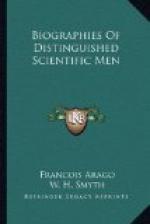These are magnificent results. The discovery of the proper motion of our system will always be accounted among Herschel’s highest claims to glory, even after the mention that my duty as historian has obliged me to make of the anterior conjectures by Fontenelle, by Bradley, by Mayer, and by Lambert.
By the side of this great discovery we should place another, that seems likely to expand in future. The results which it allows us to hope for will be of extreme importance. The discovery here alluded to was announced to the learned world in 1803; it is that of the reciprocal dependence of several stars, connected the one with the other, as the several planets and their satellites of our system are with the sun.
Let us to these immortal labours add the ingenious ideas that we owe to Herschel on the nebulae, on the constitution of the Milky-way, on the universe as a whole; ideas which almost by themselves constitute the actual history of the formation of the worlds, and we cannot but have a deep reverence for that powerful genius that has scarcely ever erred, notwithstanding an ardent imagination.
LABOURS RELATIVE TO THE SOLAR SYSTEM.
Herschel occupied himself very much with the sun, but only relative to its physical constitution. The observations that the illustrious astronomer made on this subject, the consequences that he deduced from them, equal the most ingenious discoveries for which the sciences are indebted to him.
In his important memoir in 1795, the great astronomer declares himself convinced that the substance by the intermediation of which the sun shines, cannot be either a liquid, or an elastic fluid. It must be analogous to our clouds, and float in the transparent atmosphere of that body. The sun has, according to him, two atmospheres, endowed with motions quite independent of each other. An elastic fluid of an unknown nature is being constantly formed on the dark surface of the sun, and rising up on account of its specific lightness, it forms the pores in the stratum of reflecting clouds; then, combining with other gases, it produces the wrinkles in the region of luminous clouds. When the ascending currents are powerful, they give rise to the nuclei, to the penumbrae, to the faculae. If this explanation of the formation of solar spots is well founded, we must expect to find that the sun does not constantly emit similar quantities of light and heat. Recent observations have verified this conclusion. But large nuclei, large penumbrae, wrinkles, faculae, do they indicate an abundant luminous and calorific emission, as Herschel thought; that would be the result of his hypothesis on the existence of very active ascending currents, but direct experience seems to contradict it.
The following is the way in which a learned man, Sir David Brewster, appreciates this view of Herschel’s: “It is not conceivable that luminous clouds, ceding to the lightest impulses and in a state of constant change, can be the source of the sun’s devouring flame and of the dazzling light which it emits; nor can we admit besides, that the feeble barrier formed by planetary clouds would shelter the objects that it might cover, from the destructive effects of the superior elements.”




